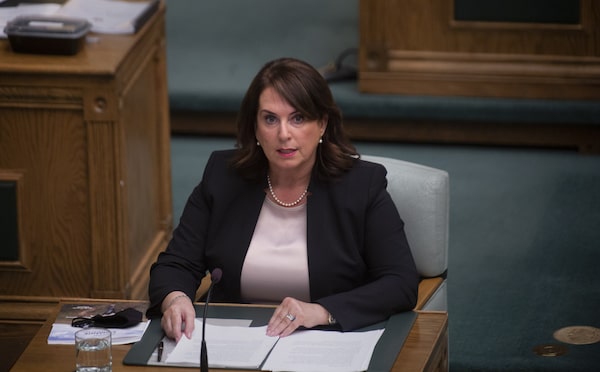
Newfoundland and Labrador Minister of Finance Siobhan Coady presents the 2021 provincial budget in St.John's on May 31, 2021.Paul Daly/The Canadian Press
The Newfoundland and Labrador government painted a rosy picture of its financial future in a $9.8-billion provincial budget tabled Thursday.
Though the budget forecasted a $160-million deficit in the 2023-24 fiscal year, the government said it will be back in the black by the end of the following fiscal year.
“We have more population, we have higher income per household, we have more people working, lower unemployment – all that contributes to a stronger economy,” Finance Minister Siobhan Coady told reporters, adding, “We are moving in the right direction.”
The province’s net debt currently sits at $15.7 billion, and it is expected to rise to $16.2 billion, which works out to approximately $30,500 per person in the province of about 531,000 people.
In a province known for carrying heavy debts and deficits, the government said it will end the 2022-23 financial year with a $784-million surplus and a record $10.5 billion in revenue.
Newfoundland and Labrador is one of the most sparsely populated jurisdictions in the country, and its population is among the oldest, sickest and most rapidly aging. Debt has long hovered over the government’s efforts to provide essential services to the many small communities spread along the province’s remote coastlines.
Doctor shortages have led to persistent closures of rural emergency rooms and about a quarter of residents are without a family physician, according to the Newfoundland and Labrador Medical Association.
Thursday’s budget touts a $3.9-billion investment in heath care, billed as the province’s “largest ever.” The funding envelope includes $9 million to integrate dozens of private ambulance operators into a publicly run system, Health Minister Tom Osborne said.
Ambulance workers for one private operator went on strike earlier this year, forcing the government to hold an emergency meeting of the legislature to declare them essential workers and get them back on the job.
Newfoundland and Labrador’s offshore oil sector was hit hard by crashing global oil prices that accompanied the onset of the COVID-19 pandemic, but Thursday’s budget anticipates an end to those troubles. Suncor’s Terra Nova field is expected to resume pumping in spring or early summer after years of delay, which means all four oilfields off the coast of St. John’s will be operating in the 2023-24 fiscal year. The province expects $1.1 billion in revenue from those fields, using an estimated oil price of US $86 per barrel.
Ottawa granted environmental approval of a fifth oil installation – Bay du Nord – last April. Norwegian energy giant Equinor is the majority shareholder and the company has not yet said if it will proceed with the project. However, officials said economic impacts from construction related to Bay du Nord were factored into economic forecasts beginning in 2025.
The province has also allocated $50 million toward a program aimed at encouraging oil companies to keep looking for oil. Coady said the program is a “redeployment” of money, rather than a subsidy.
“We want more discoveries offshore (in) Newfoundland and Labrador,” Coady said. When asked how that lined up with the province’s environmental goals, Coady said less carbon is emitted when oil is extracted from the province’s offshore than from other sources.
Environmentalists have criticized those claims, saying they only account for upstream emissions. Downstream emissions – those released when oil is ultimately burned – make up the bulk of oil’s carbon footprint.
Newfoundland and Labrador will borrow $1.5 billion in the 2023-24 fiscal year, down from $1.7 billion the year before.